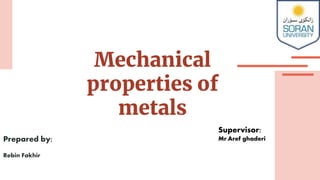
mechanical Properties of metals.pptx
- 1. Mechanical properties of metals Prepared by: Rebin Fakhir Supervisor: Mr.Aref ghaderi
- 2. Table Of Content • Introduction • Common States Of Stress • Elastic Deformaation • Anelasticity • Poisson’s Ratio • Plastic Deformation • Hardness • Types Of Hardness Testing Methods • Design/Safety Factors
- 3. Introduction How materials deform as a function of applied load → Testing methods and language for mechanical properties of materials.
- 4. Common states of sterss
- 9. Useful liner elastic relationships
- 12. Anelasticity (time dependence of elastic deformation) • Have assumed elasticdeformation is time-independent (appliedstress produces instantaneousstrain) • Elasticdeformation takes time; can continueeven after load release. Thisbehavioris known as anelasticity. • Smalleffect in metals; can be significantfor polymers (visco-elastic).
- 13. Poisson’s ratio Unloaded Loaded Tension → shrink laterally Compression → bulge
- 14. Poisson’s ratio z y z x V dimensionless Sign: lateralstrain opposite to longitudinalstrain Theoreticalvalue: for isotropic material: 0.25 Maximum value:0.50, Typicalvalue: 0.24 - 0.30
- 15. Shear Modulus Shear stress to shear strain
- 16. Elastic Modulus Poisson’s Ratio and Shear Modulus For isotropic material: Single crystals are usually elastically anisotropic Elastic behavior varies with crystallographic direction.
- 19. Plastic deformation is the permanent distortion that occurs when a material is subjected to tensile, compressive, bending, or torsion stresses that exceed its yield strength and cause it to elongate, compress, buckle, bend, or twist. Plastic Deformation
- 21. Yield point: P Where strain deviates from being proportional to stress (the proportional limit) Yield strength: oy A measure of resistance to plastic deformation Permanent strain= 0.002
- 22. Elastic Recovery: Metals can recover their original shape after being stretched to a certain limit determined by the metals yield strength. Beyond that the metal experiences plastic deformation and cannot return to its original shape. Trying to bring the metal back to its original shape results in a decrease in its length and diameter.
- 24. Tensile & yield Strength Yield Strength is the stress a material can withstand without permanent deformation or a point at which it will no longer return to its original dimensions (by 0.2% in length). Tensile Strength is the maximum stress that a material can withstand while being stretched or pulled before failing or breaking.
- 25. Ductility Some materials break very sharply, without plastic deformation, in what is called a brittle failure. Others, which are more ductile, including most metals, experience some plastic deformation and possibly necking before fracture. In materials science, ductility is the ability of a material to undergo large plastic deformations prior to failure and it is one of very important characteristics that engineers consider during design. Ductility may be expressed as percent elongation or percent area reduction from a tensile test. Ductility is an important factor in allowing a structure to survive extreme loads, such as those due large pressure changes, earthquakes and hurricanes, without experiencing a sudden failure or collapse. It is defined as:
- 27. True stress and strain
- 28. HARDNESS Another mechanical property that may be important to consider is hardness, which is a measure of a material’s resistance to localized plastic deformation (e.g., a small dent or a scratch). Early hardness tests were based on natural minerals with a scale constructed solely on the ability of one material to scratch another that was softer
- 29. Types of Hardness Testing Methods Rockwell Hardness Test During testing of hardness in Rockwell hardness tester, firstly applied minor load on a specimen generally 10 KGF then applied major load according to their scale and material These types of hardness testers are applicable for all types of materials.
- 30. Brinell Hardness Test In these types of hardness tests, a round ball is used which is forced on the work surface. These types of hardness tester are mostly applicable for material that is made up of mild steel, aluminum, low carbon steel, and copper
- 31. These types of hardness testers are mostly applicable for that material which is made up of high carbon steel, silicon carbide, tungsten, carbide, etc. Vickers Hardness Test In these types of hardness testing methods, a mark is made by applying a load with an Indentor tool (diamond pyramid) whose point angle is 136°.
- 32. Knoop Hardness Test These types of hardness tester are mostly used for very brittle and small thin metal and also used for micro size materials like memory cards, sim cards. These types of hardness tests also used the diamond pyramid as an Indentor tool.
- 35. Correlation between Hardness and Tensile Strength Both tensile strength and hardness are indicators of a metal’s resistance to plastic deformation. Consequently, they are roughly proportional, as shown in Figure 6.19, for tensile strength as a function of the HB for cast iron, steel, and brass. The same proportionality relationship does not hold for all metals, as Figure 6.19 indicates. As a rule of thumb, for most steels, the HB and the tensile strength are related according to For steel alloys, conversion of Brinell hardness to tensile strength
- 36. Computation of Average and Standard Deviation Values An average value is obtained by dividing the sum of all measured values by the number of measurements taken. In mathematical terms, the average x of some parameter x is Computation of average value where n is the number of observations or measurements and xi is the value of a discrete measurement. Furthermore, the standard deviation s is determined using the following expression: Computation of standard deviation where xi, x, and n were defined earlier. A large value of the standard deviation corresponds to a high degree of scatter